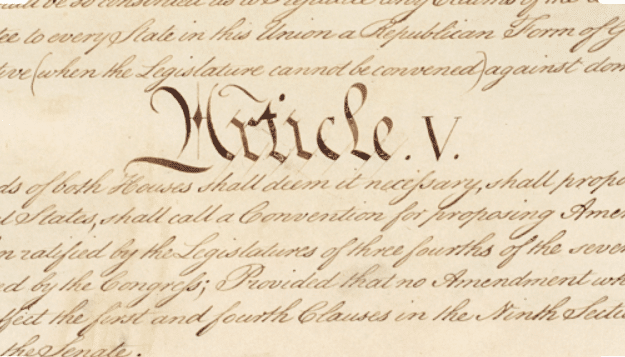
Click here or scroll down for a summary of Article 5 of the Constitution.
Article 5 of the Constitution
“The Congress, whenever two thirds of both Houses shall deem it necessary, shall propose Amendments to this Constitution, or, on the Application of the Legislatures of two thirds of the several States, shall call a Convention for proposing Amendments, which, in either Case, shall be valid to all Intents and Purposes, as Part of this Constitution, when ratified by the Legislatures of three fourths of the several States, or by Conventions in three fourths thereof, as the one or the other Mode of Ratification may be proposed by the Congress;
Provided that no Amendment which may be made prior to the Year One thousand eight hundred and eight shall in any Manner affect the first and fourth Clauses in the Ninth Section of the first Article; and that no State, without its Consent, shall be deprived of its equal Suffrage in the Senate.”
Article 5 of the Constitution summarizes how the United States Constitution can be changed or amended from its original wording.
Table of Contents
A way to change the Constitution was needed because the writers of the Constitution knew that they had not created a finished document. It was important to allow for further changes.

Several important constitutional amendments needed to be passed right away for the Constitution to get ratified, as some states vowed not to ratify the Constitution without these amendments.
Article 5 of the United States Constitution explains the Amendment Process.
These first amendments – ten in all – are collectively called the Bill of Rights .
| Topic | Article 5 of the US Constitution |
|---|---|
| Overview | Article 5 outlines the process for amending the US Constitution. |
| Requirements | To amend the Constitution, a two-thirds majority vote in both the House of Representatives and the Senate is required, or a constitutional convention must be called by two-thirds of state legislatures. |
| Proposal | A proposed amendment can be initiated by Congress or by a constitutional convention. |
| Ratification | A proposed amendment must be ratified by three-fourths of state legislatures or by special state conventions in three-fourths of the states. |
| Amendments | The Constitution has been amended 27 times since its ratification, with the most recent amendment being the 27th Amendment in 1992. |
Knowing that the country would change over time, the framers wanted the Constitution to change with the country’s times and needs.
To enable these changes, they wrote an amendment process into the Constitution. This amendment process is described in Article 5 of the Constitution.

Under the procedures specified in Article 5, the United States Constitution has been amended twenty-seven times.
The first ten were adopted in 1791 as the Bill of Rights. The other seventeen amendments were adopted between 1795 and 1992.
The 27th Amendment prohibits Congress from changing its salary compensation until after the mid-term election.
There are two ways to amend the Constitution. The first method is that an amendment can be proposed when two-thirds of both Houses deem it necessary, and it is sent to the state legislatures for approval.

The second method is for a state or states to call for a constitutional convention .
Both Houses need to approve these proposals in Congress.
In either case, an amendment proposal must pass in both the House and Senate by a two-thirds majority and then be ratified by three-quarters of the state legislatures (this would currently require ratification by 38 states).

Ratification is the process by which the states approve an amendment or a constitution to become law.
However, looking deeper, there are four ways to propose amendments to the US Constitution. Here are the four ways the Constitution can be amended:
The first is the method used for all but one of the amendments.
The fourth method was used for the 21st Amendment (which repealed the 18th Amendment , ending Prohibition).

Methods two and three have never been used to pass a constitutional amendment.
Another version of method three is that the states can call on Congress to convene a constitutional convention.
Usually, a time limit is imposed in the amendment’s writing (typically seven years) so that the process will not be dragged out indefinitely.
If the time limit expires before the required three-fourths majority ratifies the amendment, the amendment fails to become law.
The four methods to amend the Constitution are tedious and challenging to achieve. The requirement to work through both houses of Congress and the state governments’ legislatures is a significant obstacle to overcome.
A considerable number of legislators in each legislature need to agree on the need for and wording of the proposed constitutional amendment.

A two-thirds majority must be reached in the federal government legislature in both the House and Senate, and at least three-quarters of the states must ratify it. Otherwise, the proposed amendment will be defeated.
There are numerous places in this adoption process where it can go awry. For an amendment to succeed in being adopted, there must be a high degree of bipartisan cooperation.
One reason was that the framers needed to lock in the political deals made to get the Constitution ratified. Several states said they would not vote in favor of the Constitution if certain rights were not guaranteed.
Even as the Constitution’s merits were being debated in the state legislatures, the framers worked on the first twelve amendments to be adopted immediately.
Join the thousands of fellow patriots who rely on our 5-minute newsletter to stay informed on the key events and trends that shaped our nation's past and continue to shape its present.
Two of those amendments were rejected, but ten were ratified (the Bill of Rights) soon after the Constitution was adopted. As a result, Article V was created to allow amendments to be adopted to the Constitution.
The more important reason for making the amendment process difficult was a more visionary idea. The framers , like James Madison and Founding Father George Washington, felt duty-bound to make changing the Constitution a lengthy and difficult process in order to help maintain the stability of the nation’s laws.

They did not want it to be possible for arbitrary changes to be made to the Constitution, yet if changes were needed, the difficulty would guarantee that the change was needed and well thought out.
Another safeguard to keep the nation’s ruling document stable is that Article V stipulates that no amendment may change the 1st and 4th clauses in the Ninth Section of Article 1 .
Moreover, Article 5 says no amendment can deprive a state of its full representation in the United States Senate.
Article 5 also says that the US President has no role in any part of the formal amendment process.
Though there have only been 27 amendments over more than 200 years (a rate far lower than many other countries), this does not mean that constitutional change cannot happen quickly when necessary.
The 19th Amendment was ratified less than one year after being submitted to the states for consideration – proving that swift action can be taken when needed.
First, two-thirds of both houses of Congress—the House of Representatives and Senate—must propose a new amendment or approve one proposed by state legislatures.
Once passed by Congress, three-fourths of all states (38 out of 50) must ratify it within seven years from when it was first introduced in either house of Congress.
If this does not happen, then the proposal will fail unless extended by Congress itself.
In addition to these constitutional parameters, public opinion also impacts whether an amendment succeeds or fails.
If enough people oppose a particular measure, then legislators may choose not to pursue its passage further.
Ultimately, passing an amendment takes time and effort, but with careful adherence to Article 5’s guidelines, such changes are possible even today.
When considering how best to amend the constitution, it’s important to weigh up several factors.
How much support does your amendment need?
Will it require ratification from only Congress, or will other entities, such as state legislatures, need to sign off too?
Are you able to get unanimous agreement from all fifty states?
It’s essential to understand clearly which route you should take when looking at amending the constitution.
Considering all possible routes available when attempting to amend the Constitution is paramount for success. Furthermore, understanding what level of approval each option needs before passing is key; this could range from two-thirds majority votes in both houses of Congress down to a simple yes from all fifty states collectively.
Understanding these requirements ahead of time is vital for anyone seeking to introduce changes via constitutional amendment.
Surprisingly, the second and third methods of proposing an amendment to the United States Constitution have never been utilized.
The two methods in question are proposing amendments by a convention called for by Congress at the request of 2/3rds of state legislatures and proposals from state legislatures.
While these two avenues have yet to be exercised, there is still a high level of interest regarding why they haven’t been used thus far.
According to statistics, over 11,000 constitutional amendments have been proposed since 1789, with only 27 being ratified into law.
One primary reason that neither method has ever seen implementation could be attributed to the difficulty associated with either one.

For example, if we look at calling a convention as outlined in Article 5 of the constitution summary, it would require two-thirds or 34 out of 50 states to request Congress to convene such a convention.
This means that nearly all states must come together on some sort of agreement before anything happens. Additionally, 38 states need to ratify any new amendment proposed by this convention before it can become a federally binding law – making it practically impossible for certain types of amendments to pass without more widespread support across many states.
The other option available – proposing amendments through state legislatures – also presents its own set of difficulties due to differences between each individual state’s legislative process.
Each legislature is independent and may choose not to submit an amendment proposal when put forth by their constituents or another state’s legislature, let alone agree on what should constitute said proposal itself!
There are four main hurdles that make this route difficult:
These potential roadblocks ensure that few ideas can successfully navigate the path toward becoming part of our nation’s governing document.
It is clear then that although unconventional routes exist for amending the U.S. Constitution, both present unique challenges which discourage their use in practice today – leaving us still wondering why they remain untapped after so much time has passed.
Article 5 of the Constitution sets out the rules for amending it.
It states that an amendment must be proposed by either Congress or a national convention, and then ratified by three-fourths of all state legislatures or conventions in those states. One part of this process is a time limit imposed on ratification – any amendment not ratified within seven years after its proposal will not become effective as part of the Constitution.

The importance of these time limits can’t be overstated. They ensure that amendments don’t stay dormant indefinitely, waiting to gain enough support for ratification.
If no deadline was set, there would be no guarantee when an amendment might take effect, if ever. This could lead to confusion among citizens, who wouldn’t know whether something had been passed into law.
However, despite Article 5 stating two other methods besides congressional action for proposing amendments, neither has ever been used due to the difficulty in obtaining such widespread agreement.
The 7-year timeline makes gaining such unanimous consensus even more difficult since, without it, decisions can remain pending until sufficient support is achieved.
Passing an amendment to the Constitution is a daunting task, requiring as much cooperation as teamwork. As our founding fathers demonstrated so many years ago, bipartisan collaboration can be a powerful tool in achieving success and ratifying important changes to our country’s most sacred text.
Like two pieces of a puzzle fitting together perfectly, when Democrats and Republicans come together for the greater good, amazing feats can be accomplished – such as amending the Constitution.
When it comes to passing any Amendment, the importance of bipartisan agreement cannot be overstated. Here are five ways that working together across party lines makes this challenging process easier:
Though bipartisanship may not always seem easy nor possible during times of disagreement, it remains essential in ensuring the successful passage of Amendments into law and helping protect our nation’s core values for future generations.
Working together towards a common cause is made infinitely easier by understanding one another’s viewpoints and appreciating diverse opinions—ultimately leading us closer to creating more inclusive societies that embrace democracy at its best!
It is difficult to say which specific amendments to the United States Constitution have not had bipartisan support, as the level of support for an amendment can vary depending on the political climate and the specific issues at play.
However, in general, some amendments that have been contentious or divisive, such as the 16th, 17th, and 18th amendments, which established the federal income tax, direct election of senators, and prohibition of alcohol respectively, have not had unanimous support from both parties.
The 27th Amendment, which requires that any changes to congressional pay must take effect after the next election of representatives, has not had bipartisan support. It was hard to find common ground.
This is opposed to the 19th Amendment, which was widely accepted.
The 19th Amendment was a landmark in American history, granting women the right to vote. It was ratified on August 18th, 1920 and was widely accepted by the American public.
This amendment was the culmination of a long struggle for women’s rights and equality, and it has had a lasting impact on our society.
Framers of the constitution put specific guidelines in place to make sure passing an amendment would not be too easy.
This was intentional because they wanted amendments to have broad support from both sides before being passed. This means bipartisan cooperation was essential. If one party opposed an amendment, chances were high that it wouldn’t pass due to the difficulty of doing so under this system.
To understand why framers made passing an amendment so hard, consider the fact that any changes made could affect many aspects of life for Americans. They had good reason to require consensus building between the parties involved.
To ensure that only proposed amendments that had been thoughtfully discussed and considered by both sides were passed, framers set up a series of steps requiring approval from Congress and state legislatures.
In order for an amendment to become part of the Constitution today, two-thirds of each chamber must agree on it before sending it out for ratification by three-fourths of states’ legislatures or conventions. This arduous process ensures only amendments supported by the majority across political lines can be added successfully.
In Article 5, the US Constitution writers carefully crafted a document to ensure the new country’s strength and stability. As a result, the Constitution has helped maintain the United States federal government’s stability for well over 200 years.
| Arguments For Article 5 | Arguments Against Article 5 |
|---|---|
| Article 5 provides a clear and defined process for amending the Constitution, which helps ensure the document remains relevant and responsive to changing circumstances. | Article 5 sets a high bar for amending the Constitution, requiring the support of two-thirds of both houses of Congress or a convention called for by two-thirds of state legislatures. This can make it difficult to pass amendments, even when they are necessary. |
| The requirement that three-fourths of state legislatures must ratify an amendment before it becomes part of the Constitution helps ensure that changes are widely accepted and have broad support. | The process for amending the Constitution can be slow and cumbersome, which can make it difficult to address urgent or pressing issues. In some cases, the amendment process has been used to block progress and protect entrenched interests. |
| The amendment process provides a way for the Constitution to evolve and adapt over time, reflecting changing social, political, and economic conditions. | The high bar for amending the Constitution means that it is difficult to make changes, even when they are urgently needed. This can lead to a sense of frustration and disillusionment with the political system. |
| By requiring broad consensus and support for changes to the Constitution, Article 5 helps ensure that the document remains a stable and enduring foundation for American democracy. | The amendment process can be influenced by powerful interest groups, which can use their resources and influence to block changes that would threaten their position or power. |
Decoding Article 5: Uncovering the Constitution’s Secret Paths to Amendment
12th-grade students will be able to analyze and understand the processes outlined in Article 5 of the U.S. Constitution for amending the document and evaluate why alternative methods to congressional action have never been utilized.
If you would like to download a PDF with our quiz, then please go to:
Alternatively, you can take our online quiz here: